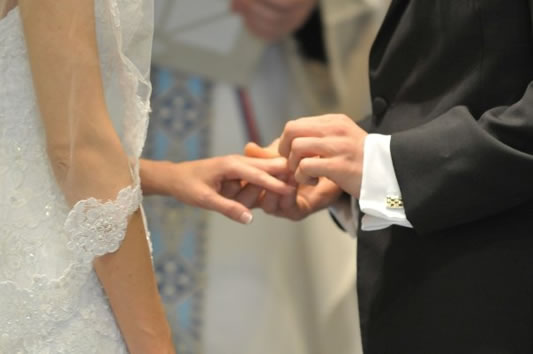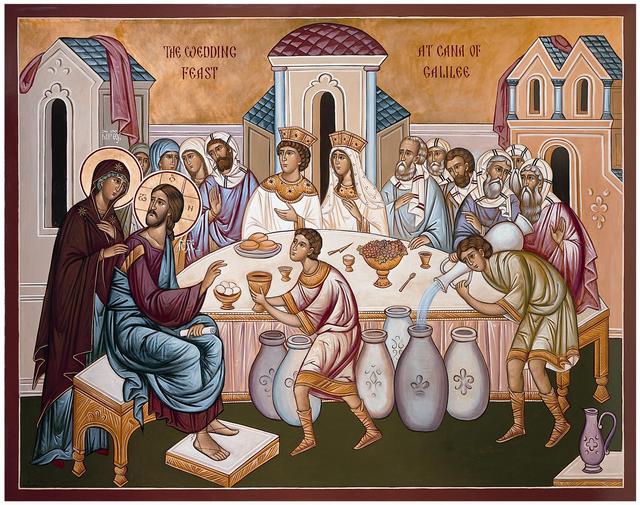 Both today’s first reading and the Gospel speak to us of the miracle of marriage. If your marriage is working even reasonably well, it is a miracle! We live in an age that is poisonous to marriage. Many people look for marriage to be ideal, and if there is any ordeal, they want a new deal. Our culture says, if it doesn’t work out, bail out. Marriages are also a miracle because they are, ultimately, a work of God.
Both today’s first reading and the Gospel speak to us of the miracle of marriage. If your marriage is working even reasonably well, it is a miracle! We live in an age that is poisonous to marriage. Many people look for marriage to be ideal, and if there is any ordeal, they want a new deal. Our culture says, if it doesn’t work out, bail out. Marriages are also a miracle because they are, ultimately, a work of God.
Today’s readings bring before us some fundamental teachings on marriage. Let’s look at today’s Gospel in five stages.
I. Rejection – The Gospel opens with the Pharisees approaching Jesus and asking, somewhat rhetorically, “Is it lawful for a husband to divorce his wife?” Jesus, aware of their hypocrisy (they do not really want an answer from Him on which to base their lives), asks them in return, “What did Moses command you?” They gleefully respond, in essence, that Moses permitted a husband to divorce his wife as long as he “filled out the paperwork,” if you will.
Jesus will have none of it, telling them that Moses only permitted this regrettable thing called “divorce” because of their hardened hearts.
Among the rabbis of Jesus’ time, there was the belief that this seemingly lax provision permitting divorce resulted because Moses had reasoned that if he were to say to the men of his day that marriage was until death then some of them might very well have arranged for the death of their wives. So, in order to prevent homicide, Moses permitted the lesser evil of divorce. It was still an evil, however. God Himself says in the Book of Malachi,
And this again you do. You cover the Lord’s altar with tears, with weeping and groaning because he no longer regards the offering … You ask, “Why does he not?” Because the Lord is witness to the covenant between you and the wife of your youth, to whom you have been faithless, though she is your companion and your wife by covenant. Has not the one God made and sustained for us the spirit of life? And what does he desire? Godly offspring. So, take heed to yourselves, and let none be faithless to the wife of his youth. For I hate divorce, says the Lord, the God of Israel, and covering one’s garment with violence, says the Lord of hosts. Yes … take heed to yourselves, and do not be faithless” (Malachi 2:13–16).
Thus, in the opening lines of today’s Gospel, Jesus highlights how the Pharisees and many other men of His time have rejected God’s fundamental teaching on marriage. Jesus is about to reiterate that teaching. For now, though, just note that the rejection evidenced in the question of the Pharisees is one that Jesus ascribes to hearts that have become hardened by sin, lack of forgiveness, and refusal to accept God’s plan.
God hates divorce not only because it intrinsically rejects what He has set forth but also because it is symptomatic of human hardness and sinfulness.
II. Restoration – Jesus, having encountered their hardened hearts, announces a restoration, a return to God’s original plan for marriage. The Lord quotes the Book of Genesis, saying,
But from the beginning of creation God made them male and female. And for this reason a man shall leave his father and mother, and be joined to his wife, and the two shall become one flesh. So they are no longer two, but one flesh. Therefore, what God has joined together, no human being must separate.
Note that Jesus begins with the phrase, “but from the beginning of creation.” In other words, anything that may have happened in the aftermath of Original Sin, any compromises or arrangements that have emerged during the reign of sin, are now to be done away with in the reign of grace that will come as the result of Jesus’ saving death and resurrection.
On account of the grace that will be bestowed, we are now able, and expected, to return to God’s original plan for marriage: one man and one woman in a lifelong, stable relationship that is fruitful, bringing forth godly children for God and His kingdom. This is God’s plan, a plan that has no room for divorce, contraception, or anything other than fruitful, faithful, stable love.
In today’s Western culture there have been many attempts to redefine God’s original and perfect plan for marriage, substituting something erroneous, something humanly defined. While current attempts to redefine marriage to include same-sex unions are a particularly egregious example, they are not the first or only way in which God’s plan for marriage has been attacked.
The attempts began in the 1950s, when divorce began to occur among Hollywood celebrities (e.g., Ingrid Bergman). Many Americans, who seem to love and admire their Hollywood stars, began to justify divorce. “Don’t people deserve to be happy?” became the refrain. In this way marriage, which up to that point had as its essential focus what was best for children, began subtly but clearly to be centered on what was best for adults. The happiness of the adults began to take precedence over well-being of the children in the mind of most people.
During the 1950s and 1960s pressure began to build to make divorce easier. Until the late 1960s, divorces had been legally difficult to obtain in America; wealthier people often traveled to Mexico to secure them. In 1969, California Governor Ronald Reagan signed the first “no-fault” divorce law, making divorces fairly easy to obtain. Within ten years most states had similar laws. As a result, divorce rates skyrocketed.
This was the first redefinition of marriage. No longer was a man to leave his father and mother and “cling to his wife.” Now, at the first sign of trouble, men and women could just renege on their marriage vows, in direct contradiction to God’s plan. Thus, we engaged in what amounts to a redefinition of marriage.
The second redefinition of marriage occurred when the contraceptive mentality seized America. It began in the late 1950s and continues to this day. Though God said to the first couple, Be fruitful and multiply, fill the earth … (Genesis 1:28), children have become more a way of “accessorizing” a marriage than an integral part and an expected fruit. Children are no longer seen as an essential purpose of marriage, but only an optional outcome based on the wishes of the adults. This directly contradicts God’s instruction to “be fruitful and multiply.”
The third redefinition of marriage—the current rage—is the attempt to extend it to include same-sex unions. The absurdity of this proposal flows from the sinful conclusions of the first two redefinitions, which in effect state that marriage is simply about two adults being happy and doing whatever pleases them.
If that is truly the case, then there seems little basis to protest same-sex couples getting “married,” or, frankly, any number of adults in any combination of sexes, getting “married.” (Polygamy and/or polyandry are surely coming next.)
The heterosexual community has misbehaved for over fifty year now, redefining essential aspects of marriage. The latest absurdity—and it is an absurdity—of gay “marriage” flows from this flawed and sinful redefinition. We have sown the wind; now we are reaping the whirlwind.
In the end, Jesus will have none of this. He rejects the attempts of the men of His time to redefine marriage. Through His Church, His living voice in the world today, He also rejects the sinful and absurd redefinitions that our culture proposes, be it divorce, contraception, or homosexual “marriage.”
God has set forth that a man should leave his father and mother and cling to his wife, and that the two of them become one flesh. In making a suitable partner for Adam, God created Eve, not Steve; hence homosexual unions are excluded. A man is not a suitable partner for a man; a woman is not a suitable partner for a woman. Further, in making a suitable partner for Adam, God did not make Eve and Ellen and Jane and Sue and Beth. Hence, polygamy, though mentioned and tolerated for a time in the Bible (but always a source of trouble) is also not part of God’s plan.
God intends one man, for one woman, in a relationship of clinging; that is, in a stable relationship that bears the fruit of godly offspring.
This is the Lord’s plan; Jesus does not entertain any notion from the people of His day that will alter or compromise the original design for marriage. He thus announces a restoration of God’s original plan for marriage, as set forth in the book of Genesis.
III. Reality – As is true today, Jesus’ reassertion of traditional, biblical marriage was met with controversy. In Matthew’s account, many of the disciples react with disdain, saying, If that is a case of a man and his wife, it is better never to marry (Matt 19:10).
In today’s Gospel we see that the disciples are somewhat troubled by what Jesus says and ask Him about it again later. Jesus does not back down; He even intensifies His language, saying, Whoever divorces his wife and marries another commits adultery against her; and if she divorces her husband and marries another, she commits adultery.
There will be no apology from Jesus: divorce/remarriage is adultery. There may have been some in Jesus’ time (and today) who would hold up their divorce papers and say that they have a divorce decree. Jesus implies that He is not impressed with some papers signed by a human judge and is not bound by the decision of some secular authority. What God has joined together, no man must separate. Jesus once again establishes that once God has joined a couple in Holy Matrimony, the bond which God has effected is to be respected by all, including the couple.
Marriage has a reality beyond what mere humans bring to it or say of it. Marriage is a work of God; it has a reality and an existence that flows from God’s work, not man’s. All of our attempts to redefine, obfuscate, or alter marriage as God has set it forth are sinful and not recognized by God.
IV. Reemphasis – Now comes an interesting twist, which includes a reminder of one of the most essential purposes of marriage:
And people were bringing their little children to Jesus that he might touch them, but the disciples rebuked them. When Jesus saw this, he became indignant and said to them, “Let the children come to me; do not hinder them, for the kingdom of God belongs to such as these.”
This is not a new element to the story; neither have we gone into a separate pericope. Rather, Jesus’ remarks about children remind us of the essential reason that marriage is structured the way it is. Why should marriage be between two heterosexuals? Why should it be stable? Why should it include a father and a mother rather than two fathers, or two mothers, or just a mother, or just a father?
The fundamental answer is that the essential work of marriage is to procreate and then raise those children. Because children are marriage’s most fundamental fruit, it makes sense that marriage should be structured based on what is best for them. The fact is, children are best raised in a stable, lasting environment in which their parents have committed to each other in mutual support and partnership in raising them. Further, it makes sense psychologically that a child should receive influence from both father and mother, the male parent and the female parent. There are things that a father can teach a child that a mother cannot; there are things that a mother can teach a child that a father cannot. Psycho-social development is best achieved in the environment that God and nature have set forth: every child growing up with both a father and a mother, a male and a female influence.
Anything else amounts to something that is less than ideal. To the degree that we intentionally impose the less-than-ideal on children, we are guilty of doing them an injustice. Bringing children into the world prior to marriage or apart from it, such that they will be raised in a single-parent home, is an injustice. It is even more unjust that children conceived under these promiscuous circumstances are far more likely to be aborted.
This preference for stable, lasting, heterosexual unions clearly excludes homosexual ones. Same-sex “parents” are far from ideal for a child. To raise children in such circumstances intentionally is an injustice, for it is to subject them to that which is unnatural and far from ideal.
Catholics have every obligation both to uphold and insist upon traditional marriage as what is right and just, not only because it is God’s plan, but because it is clearly what is best for children. Marriage is fundamentally about children. It is not simply religious sensibility that should lead us to this position; it is a position deeply rooted in natural law, common sense, and what is best for children.
Traditional marriage should be encouraged in every way. Becoming “fuzzier” about what marriage is, or “defining it down” does not help our culture to esteem traditional marriage. Traditional marriage has pride of place because it is focused on raising the next generation and is critical to the essential functioning of our society.
There is much talk today about the rights of people to do as they please. So-called gay “marriage” is presented within this framework. Sadly, many who discuss rights only refer to the rights of adults; they seem to care much less about what is best for children. What is good and right for children needs to have a much higher priority in our culture today than it currently does.
Jesus reemphasizes the teaching on marriage by pointing to the young children before them and telling the disciples not to hinder the children. One of the clearest ways we hinder children from finding their way to God and His kingdom is with our own bad behavior: promiscuous sexual acts (endangering children through abortion or single-parent households), divorce (placing children in divided situations and saddling them with confused loyalties), and insistence on adult rights taking precedence over what is best for children. To emphasize all of this bad behavior, Jesus points out the young children and says, “Do not hinder them.” Our bad behavior does hinder them.
V. Reassurance – To be sure, this teaching about marriage is to some degree “heavy weather.” Indeed, many in our culture have tried, and failed, to attain to the vision of marriage that the Lord teaches. There are complicated reasons, too many to note here, that so many people struggle to live this teaching today.
Whatever our own failures have been, we need to go to the Lord with a childlike trust, a trust that cries out for help. Jesus says at the conclusion of today’s Gospel, Amen, I say to you, whoever does not accept the kingdom of God like a child will not enter it.
Children often feel overwhelmed, and when they do they run to their parents for help. It is in this spirit that the Lord asks us to receive this teaching. Indeed, many may well have to run to God and say “Abba, God, I don’t know how to live this teaching. My marriage is in ruins, and I don’t know how to save it. I’ve tried, but my spouse is unwilling. I can’t go back and undo what I did years ago.”
Note how the Lord embraces the child in this Gospel. He is willing to embrace us as well, in our failures and our difficulties. If we have failed, we should be like a young child and run to the Father. What we should avoid most is being relentlessly adult-like, digging in our heels and saying, “God is unreasonable; the Gospel is unreasonable!”
In the end, only God can accomplish strong marriages and strong families for us. We must run to Him as Father and seek His help. Even if one has failed in his/her marriage, one must still impart to the next generation what God teaches.
God’s plan remains His plan for everyone, no matter our personal failings. We have every obligation to run to Him, trust Him, and ask for His help. Even in the midst of our own personal failures, we can and must announce and celebrate the truth to others. In the end, God does not give us His teaching in order to burden us or to accuse us but rather to bless us. We must be assured of His mercy and His ability to write straight, even with the crooked lines of our lives.
If we in this generation have failed, and many of us have failed, we must still announce God’s plan for marriage to the next generation. We must not cease to hand on God’s perfect plan.









